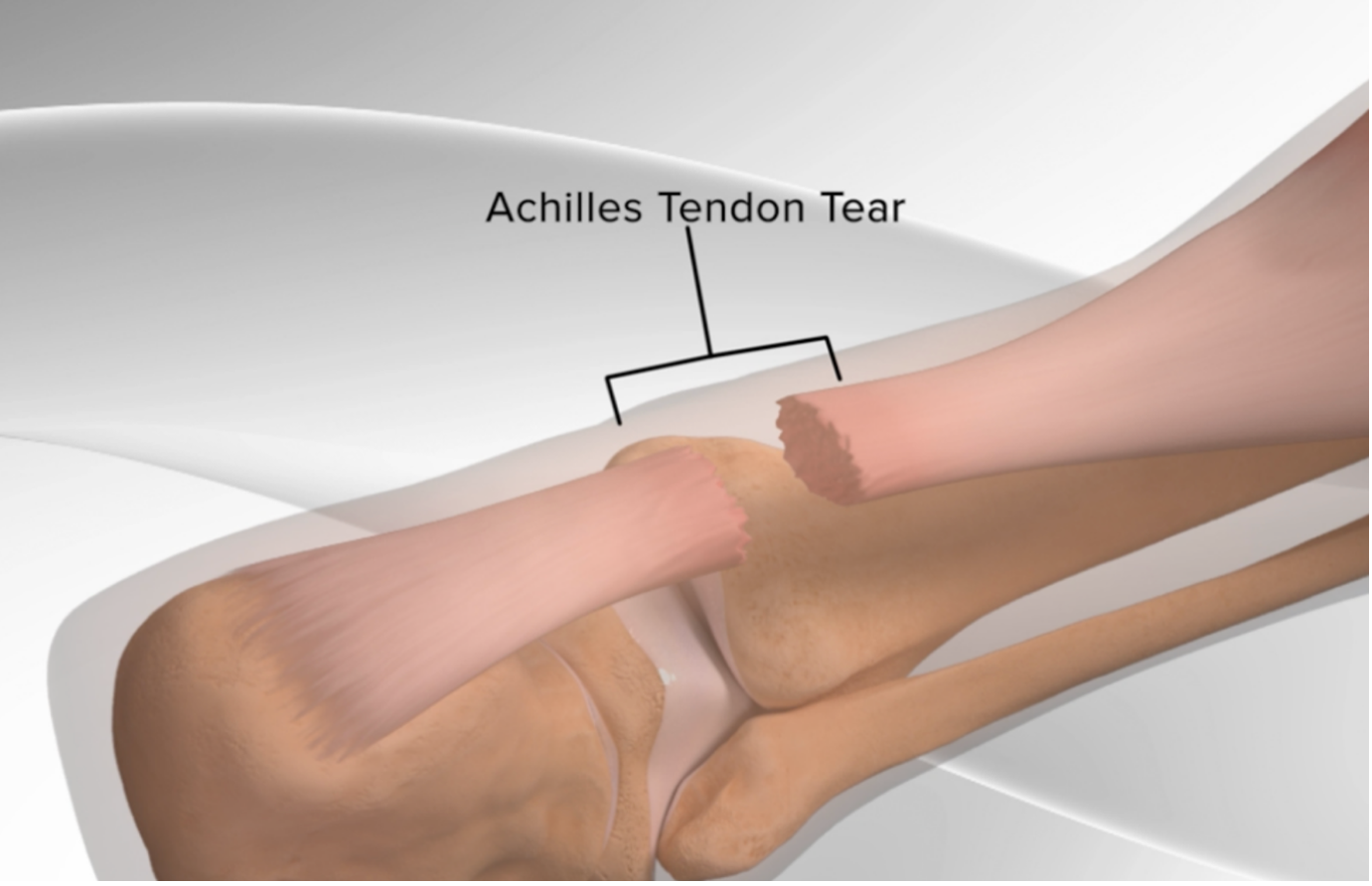The Achilles tendon is the largest and strongest tendon in the human body, connecting the calf muscles (gastrocnemius and soleus) to the heel bone (calcaneus). This tendon is crucial for walking, running, and jumping, as it allows the foot to push off the ground by transmitting the force generated by the calf muscles. The Achilles tendon enables plantarflexion, the motion of pointing the toes downward, which is essential for activities like standing on tiptoe, climbing stairs, and propelling the body forward during movement.
What is an Achilles Tendon Rupture?
An Achilles tendon rupture occurs when the tendon is stretched beyond its capacity, causing it to tear either partially or completely. This injury typically occurs during activities that involve sudden acceleration, deceleration, or forceful push-off motions, such as sprinting, jumping, or pivoting. The rupture usually happens about 2 to 6 centimeters above the heel bone, where the tendon is most vulnerable due to its relatively poor blood supply.
What Happens When the Achilles Tendon Ruptures?
When the Achilles tendon ruptures, there is a sudden and severe disruption in the continuity of the tendon fibers. This rupture impairs the ability of the calf muscles to exert force through the tendon, significantly affecting the function of the foot and ankle. As a result, the affected individual may find it difficult or impossible to push off the ground with the injured leg, leading to a significant reduction in mobility and strength.
Individuals who experience an Achilles tendon rupture often describe a sudden, sharp pain in the back of the ankle or calf, similar to being struck or kicked in the area. This is often accompanied by an audible “pop” or “snap” sound. Following the initial injury, the pain may subside to some extent but is typically followed by swelling, bruising, and difficulty walking. There is usually a noticeable weakness in the affected leg, and the person may be unable to stand on tiptoe or push off with the foot.

How is an Achilles Tendon Rupture Diagnosed?
Diagnosis of an Achilles tendon rupture begins with a thorough clinical examination. The physician will inquire about the injury’s circumstances and perform a physical examination, often including specific tests such as:
Thompson Test (Squeeze Test): The patient lies face down with their feet hanging off the edge of the examination table. The physician squeezes the calf muscle; in a healthy tendon, this should cause the foot to plantarflex (point downward). Lack of movement indicates a rupture.
Palpation: The physician may feel for a gap or defect in the tendon where it has ruptured.
Imaging: While many ruptures can be diagnosed clinically, imaging studies like ultrasound or MRI may be used to confirm the diagnosis, assess the extent of the injury, and plan treatment.
How is an Achilles Tendon Rupture Treated?
Treatment for an Achilles tendon rupture can be either surgical or non-surgical, depending on factors such as the patient’s age, activity level, and the severity of the rupture.
Non-Surgical Treatment
Immobilization: The affected leg is placed in a cast, boot, or brace that keeps the foot in a slightly pointed position (plantarflexion) to allow the tendon ends to come together and heal. The foot position is gradually adjusted as healing progresses.
Rehabilitation: Physical therapy is essential to regain strength, flexibility, and range of motion. Rehabilitation typically involves a structured program that progresses through various phases of recovery.
Advantages and Disadvantages: Non-surgical treatment avoids the risks associated with surgery, such as infection or nerve damage. However, there may be a higher risk of re-rupture or incomplete healing compared to surgical treatment.
Surgical Treatment
Surgical repair is often recommended for younger, more active patients or those who wish to return to high levels of physical activity. The surgery aims to reattach the torn ends of the tendon to restore its normal function.
Click below to explore Mr Schneiders surgical treatments of Achilles tendon.
Prevention of Achilles Tendon Rupture
Preventing an Achilles tendon rupture involves maintaining strong and flexible calf muscles, gradually increasing the intensity of physical activity, and avoiding sudden or excessive stress on the tendon. Warming up before exercise, incorporating regular stretching, and wearing appropriate footwear can also reduce the risk of injury. For those at higher risk, such as athletes, structured strength training and conditioning programs may be beneficial.
Summary
An Achilles tendon rupture is a significant injury that affects the largest tendon in the body, critical for lower limb function. While the injury is serious, with proper diagnosis and treatment—whether surgical or non-surgical—most individuals can expect to recover and regain function, though the process requires time and dedication to rehabilitation. Preventative measures and early intervention are key to minimizing the risk and impact of this injury.

